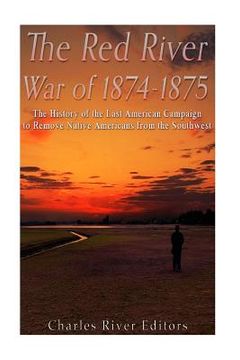The Red River War of 1874-1875: The History of the Last American Campaign to Remove Native Americans from the Southwest (en Inglés)
Reseña del libro "The Red River War of 1874-1875: The History of the Last American Campaign to Remove Native Americans from the Southwest (en Inglés)"
*Includes pictures *Includes accounts of the fighting written by participants *Includes footnotes, online resources and a bibliography for further reading *Includes a table of contents From the "Trail of Tears" to Wounded Knee and Little Bighorn, the narrative of American history is incomplete without the inclusion of the Native Americans that lived on the continent before European settlers arrived in the 16th and 17th centuries. Since the first contact between natives and settlers, tribes like the Sioux, Cherokee, and Navajo have both fascinated and perplexed outsiders with their history, language, and culture. But among all the Native American tribes, the Spanish, Mexicans, and Americans learned the hard way that the warriors of tribes in the Southwest, most notably the Apache and Comanche, were perhaps the fiercest in North America. While the Apache are inextricably associated with one of their most famous leaders, Geronimo, the conflict between the Comanche and white settlers in the Southwest was particularly barbaric. During Comanche raids, all adult males would be killed outright, and sometimes women and children met the same fate. On many occasions, older children were taken captive and gradually adopted into the tribe, until they gradually forgot life among their white families and accepted their roles in Comanche society. Popular accounts written by whites who were captured and lived among the Comanche only brought the terror and the tribe closer to home among all Americans back east as well. As the 19th century progressed, the "Buffalo Indians," as the various groups in the region were called, were well adapted and thrived in their environment. The middle of the century, however, proved to be increasingly challenging to the Native American tribes as the U.S. government sought to contain, if not eliminate, these nomadic hunters in order to exploit the region and its resources for the advancement of westward expansion. When the Civil War came to an end at last in 1865, it allowed for an increased military presence in Texas and the Southern Plains region. Further, the intercontinental railroad was completed in 1868, which increased the rate of the transportation of goods to the East and migrant settlers to the West. The threat of civilians encountering hostile Native tribes was prevalent, and in order for the U.S. government to promote white settlement in the Southern Plains, the "Indian Problem," needed to be swiftly addressed. The Indian Bureau and Native Americans of the region agreed to scantily enforced treaties that were skewed largely in favor of the government, while native elders saw little choice but to sign the treaties, aware of the might of the American military and understanding that without the pacts, the possibility of a war was likely. When the treaties went unenforced and the Native Americans got little of the relief promised by the government, war did, in fact, follow. Tensions had risen in the region over several decades, and the outbreak of war came in 1874 due to the increased encroachment of white buffalo hunters onto Native American soil, the lack of enforcement of the Medicine Lodge Treaty, and the attitudes of military leaders toward Native Americans. The Red River War of 1874-1875 pitted the Southern Plains tribes against the U.S. Army, and it would prove to be the final Indian war in the region. The Red River War of 1874-1875: The History of the Last American Campaign to Remove Native Americans from the Southwest comprehensively covers the climactic clashes between the two sides. Along with pictures of important people, places, and events, you will learn about the Red River War like never before.

